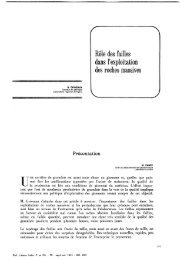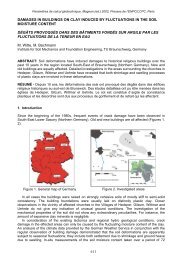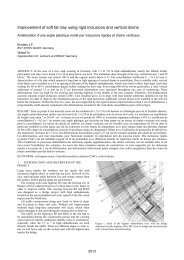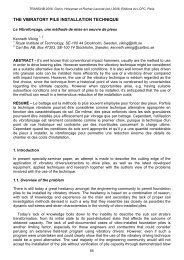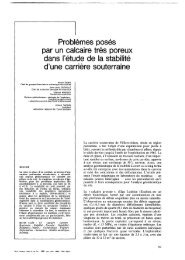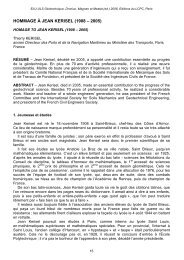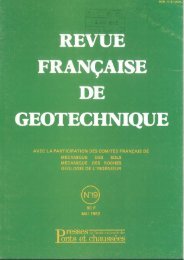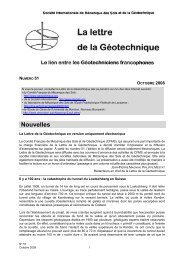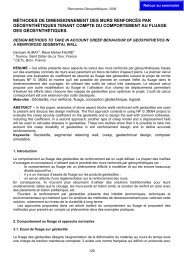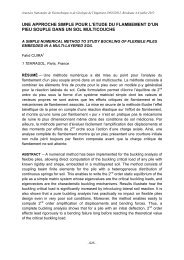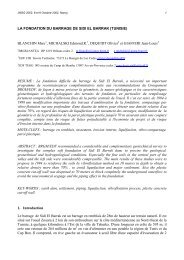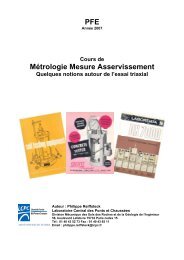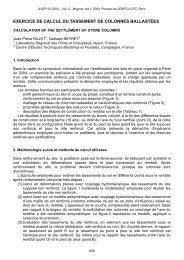Over-Soft Clay
Over-Soft Clay
Over-Soft Clay
You also want an ePaper? Increase the reach of your titles
YUMPU automatically turns print PDFs into web optimized ePapers that Google loves.
Proceedings of the 18 th International Conference on Soil Mechanics and Geotechnical Engineering, Paris 2013Proceedings of the 18 th International Conference on Soil Mechanics and Geotechnical Engineering, Paris 2013uniform”. The minimum bearing capacity occurs at= 2, COV = 0.1 and 0.3, and and = 0.1, 1 and 10.capacity of a strip footing penetrating stiff-over-soft clay was Canadian geotechnical conference, Montreal, Quebec.conducted by taking the spatial variability of undrained strength Paice, G. M., Griffiths, D. V. and Fenton, G. A. (1996). "Finite Elementinto account. The results indicate that with high spatialModeling of Settlements on Spatially Random Soil." ASCE Journalof Geotechnical Engineering 122(9): 777-779.variability in the undrained shear strength there is a significantPopescu, R., Deodatis, G. and Nobahar, A. (2005). "Effects of Randomreduction in the bearing capacity. Mean bearing capacity factors Heterogeneity of Soil Properties on Bearing Capacity."and statistical distributions were provided for 12 cases of s ut /s ub Probabilistic Engineering Mechanics 20(4): 324-341..For the case of top layer thickness equal to the strip footing3.4 Stochastic soil cases: variation of correlation length inbottom layerwidth presented it was shown that variation in the top layer hada greater effect on reducing the bearing capacity (whencorrelation distance was held constant). This was due to theunsymmetric bearing capacity shortening further into the toplayer.Comparison of the results of case 9, 10, 1, 11 and 12The empirical probabilities of exceedence of the deterministicindicates the correlation length effect of the bottom layer. Itbearing capacity factor in the stochastic case differ from case toagain shows that increasing horizontal correlation length tendscase, ranging from on the order of 10 -4 to 0.277, thus attestingto increase the standard deviation of the bearing capacity factorfor the influence of the magnitude of spatial variability and(see Table 1 and Figure 6). However, the largest averageuncertainty on the effects of stochastic modelling. Thebearing capacity corresponds to the minimum correlation lengthmaximum value observed for case 7 is well below a “central”case (case 1:). This differs to what isvalue of 0.5; hence, overall, it is assessed that the deterministicoccurring in the top layer. The maximum average bearingcase is significantly unconservative from an engineeringcapacity corresponds to the largest correlation length case 11,standpoint.which is consistent with the results of changing the correlationThe conclusions drawn in this paper may be specific for thelength of the top layer.geometery and soil conditions analysed. The 12 cases presentedhere, however, represent a small subset of 1600 cases analysedin a more ambitious numerical experiment. Cases of (i)= 4/3 and 2, (ii) COV = 0.1 and 0.3, (iii) and= 0.1, 1 and 10, as well as (iv) a gradient of increasingundrained shear strength with depth, and (v) a footingembedded to 0.5B into the top layer, make up the fullprogramme. The results of the larger study will be published indue course.5 ACKNOWLEDGEMENTSThis research is being undertaken with support from theAustralia-China Natural Gas Technology Partnership Fund andThe Lloyd’s Register Educational Trust.6 REFERENCESCassidy, M.J., Uzielli, M. and Tian, Y. (2012) "Probabilistic CombinedFigure 7. Cumulative probability curves for variation ofLoading Failure Envelopes of a Strip Footing on Spatially Variablecorrelation distance in the top layer (cases 1, 5, 6, 7 and 8)Soil". Computers and Geotechnics, In Press. http//dx.doi.org/10.1016/j.compgeo.2012.10.008Dassault Systèmes (2010) "Abaqus Analysis User’s Manual"Fenton, G. A. (1994). "Error Evaluation of Three Random-FieldGenerators". J. Eng. Mech., 120(12), 2478–2497.Fenton, G. A. and Griffiths, D. V. (2003). "Bearing-Capacity Predictionof Spatially Random C-Phi Soils." Canadian Geotechnical Journal40(1): 54-65.Fenton, G. A. and Griffiths, D. V. (2008). "Risk Assessment inGeotechnical Engineering". Hoboken, N.J., John Wiley & Sons.Fenton, G. A. and Vanmarcke, E. H. (1990). Simulation of RandomFields via Local Average Subdivision. J. Eng. Mech., 116(8),1733–1749.Griffiths, D. V. and Fenton, G. A. (2001). "Bearing Capacity ofSpatially Random Soil: The Undrained <strong>Clay</strong> Prandtl ProblemRevisited." Geotechnique 51(4): 351-359.Griffiths, D. V., Fenton, G. A. and Manoharan, N. (2002). "BearingCapacity of Rough Rigid Strip Footing on Cohesive Soil:Probabilistic Study." Journal of Geotechnical andGeoenvironmental Engineering 128(9): 743-755.Kasama, K. and Whittle, A. J. (2011). "Bearing Capacity of SpatiallyFigure 8. Cumulative probability curves for variation ofcorrelation length in bottom layer (cases 9, 10, 1, 11 and 12)Random Cohesive Soil Using Numerical Limit Analyses." Journalof Geotechnical and Geoenvironmental Engineering 137(11): 989-996.4 CONCLUSIONSMerifield, R. S., Sloan, S. W. and Yu, H. S. (1999). "Rigorous PlasticitySolutions for the Bearing Capacity of Two-Layered <strong>Clay</strong>s."Geotechnique 49(4): 471-490.Nobahar, A. and Popescu, R. (2000). "Spatial Variability of SoilIn this study, finite element analysis of the vertical bearing Properties - Effects on Foundation Design". Proceedings of 53rd3478



